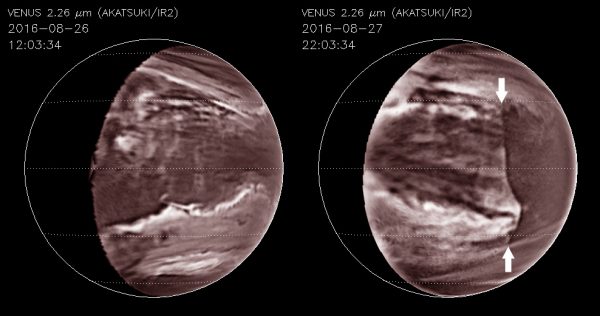A planetary-scale cloud discontinuity has been periodically lashing the depths of the thick blanket of clouds on Venus for at least 35 years, says a study with the participation of the Instituto de Astrofísica e Ciências do Espaço (IA).
In the cloudy heavens of Venus, consisting mostly of carbon dioxide with clouds made of droplets of sulphuric acid, a giant atmospheric disruption, not yet seen elsewhere in the Solar System, has been rapidly moving at around 50 kilometres above the hidden surface, and unnoticed for at least 35 years. Its discovery is reported in a study1 now published in the Geophysical Research Letters and had the contribution of Pedro Machado, of Instituto de Astrofísica e Ciências do Espaço (IA2) and Faculdade de Ciências da Universidade de Lisboa (Ciências ULisboa).
If this happened on Earth, this would be a frontal surface at the scale of the planet, and that’s incredible
Pedro Machado
This planet-wide cloud discontinuity can sometimes extend as far as 7500 kilometres, across the equator, from 30º north to 40º south, and happens at the lower cloud level, at altitudes between 47.5 and 56.5 kilometres. It was now discovered that since at least 1983 this wall of acid clouds is periodically swiping the solid globe in five days, at about 328 kilometres per hour.
The study was led by the Japanese space agency JAXA, which first spotted what looked like an atmospheric wave, but of planet size proportions. This was hinted from the infrared images of great detail taken from the nightside of the planet by the Venus orbiter Akatsuki, of JAXA, which probed the mid and lower layers of the atmosphere.

Animated file available here
Credits: Javier Peralta/JAXA-Planet C team.
“If this happened on Earth, this would be a frontal surface at the scale of the planet, and that’s incredible,” says Pedro Machado. “Under the follow-up campaign, we went back to images I took in the infrared in 2012 with the Galileo National Telescope (TNG), in Canary Islands, and we found precisely the same disruption.”
IA contributed not only with past work, under its long research programme studying Venus’ winds, but also with follow-up observations with NASA’s Infrared Telescope Facility (IRTF), in Hawaii, coordinated with new observations made from space with the Akatsuki orbiter.
While other giant cloud patterns have been observed in the atmosphere of Venus, such as the Y wave3 or the 10,000 kilometres long bow-shaped stationary wave on the upper clouds, this is the first serious candidate to planetary wave found at low altitudes.
The deep region in the atmosphere where this new disruption was discovered is responsible for the rampant greenhouse effect that retains the heat and keeps the surface at a temperature of 465 degrees Celsius (enough to melt lead). Planetary-scale waves such as this might help establish a link between the surface and the dynamics of the Venusian atmosphere as a whole, which, to an extent, is still a mystery.
“Since the disruption cannot be observed in the ultraviolet images sensing the top of the clouds at about 70 kilometres height, confirming its wave nature is of critical importance,” says Javier Peralta, who led this study. “We would have finally found a wave transporting momentum and energy from the deep atmosphere and dissipating before arriving at the top of the clouds. It would therefore be depositing momentum precisely at the level where we observe the fastest winds of the so-called atmospheric super-rotation4 of Venus, whose mechanisms have been a long-time mystery.”

Credits: Javier Peralta/JAXA-Planet C team
However, the mechanism that ignited and maintains with cycles of varying intensity the long-lasting phenomenon now discovered is still unknown, despite computer simulations trying to mimic it. According to the researchers, this atmospheric disruption is a new meteorological phenomenon, unseen on other planets, and because of this it is yet difficult to provide a confident physical interpretation.
While it will be the focus of future research, the authors suggest that this disruption may be the physical manifestation of an atmospheric wave of Kelvin type, propagating trapped about the equator. Kelvin waves are a class of atmospheric gravity waves5 that share important common features with this disruption. For instance, they propagate in the same direction as the super-rotating winds and with no apparent effect on the winds blowing from the equator towards the poles, the meridional winds.
Kelvin waves can interact with other types of atmospheric waves like the ones that naturally occur as a result of the rotation of the planet, the Rossby waves. These may cause the transport of energy of the super-rotation to the equator.
Revisiting images taken as far back as 1983, the researchers were able to confirm the presence of the same features. According to Pedro Machado, it was unnoticed for so long because “we needed access to a large, growing and scattered collection of images of Venus gathered in the recent decades with different telescopes.”
Notes
- The article “A Long-Lived Sharp Disruption on the Lower Clouds of Venus”, by Javier Peralta et al. was published on 16th June, 2020, in the journal Geophysical Research Letters, Vol. 47, Issue 11 (DOI: https://doi.org/10.1029/2020GL087221).
- The Instituto de Astrofísica e Ciências do Espaço (Institute of Astrophysics and Space Sciences – IA) is the reference Portuguese research unit in this field, integrating researchers from the University of Lisbon and the University of Porto, and encompasses most of the field’s national scientific output. It was evaluated as Excellent in the last evaluation of research and development units undertaken by Fundação para a Ciência e Tecnologia (FCT). IA’s activity is funded by national and international funds, including FCT/MCES (UID/FIS/04434/2019).
- The Y wave, thus called due to its shape, is a giant dark structure that covers nearly the whole planetary disc. It is located at upper level of the dense blanket of clouds on Venus, and is only visible when observed in the ultraviolet. Its origin was a mystery for decades, until it was explained by an international team in which participated researchers of Instituto de Astrofísica e Ciências do Espaço.
- Venus rotates slowly (in the opposite direction of Earth and the majority of the Solar System planets), taking 243 Earth days to complete a Venusian day. However, its atmosphere turns 60 times faster. The super-rotation of the atmosphere of Venus is the fact that the winds parallel to the equator, or zonal winds, make the atmosphere circle the planet in just little more than four Earth days. As a consequence, the normal wind speed relative to the surface is about 360 km/h.
- Gravity waves (not to be mistaken for gravitational waves) are fluctuations in a fluid medium. They are caused by displacements of the medium from its stable position relative to the force of gravity, and propagate as the medium tries to restore its equilibrium. Sea waves, either caused by the wind or by maritime currents going over seabed reliefs in shallow waters, are examples of gravity waves.
Contacts
Pedro Machado
Science Communication Group
Sérgio Pereira ; Ricardo Cardoso Reis ; João Retrê (coordination, Lisbon); Daniel Folha (coordination, Porto).

